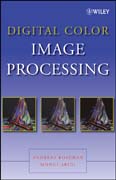
Organized in regard to advanced techniques for three-dimensional scene analysis in color images, Digital Color Image Processing is divided into four parts that cover the fundamentals and requirements for color image processing, techniques for preprocessing color images, three-dimensional scene analysis using color information, and the new increasing area of multi-spectral imaging. Two case studies on applications of color image processing are included. INDICE: 1. Introduction. 1.1 Goal and Content of This Boo. 1.2 Terminologyin Color Image Processin. 1.2.1 What Is A Digital Color Image? 1.2.2 Derivative of a Color Image. 1.2.3 Color Edges. 1.2.4 Color Constancy. 1.2.5 Contrast of a Color Image. 1.2.6 Noise in Color Images. 1.2.7 Luminance, Illuminance, and Brightness. 1.3 Color Image Analysis in Practical Use. 1.4 References to Further Reading. 1.5 References. 2. Eye and Color. 2.1 Physiology of Color Vision. 2.2 Receptoral Color Information. 2.3 Postreceptoral Color Information. 2.4Cortical Color Information. 2.5 References. 3. Color Spaces and Color Distances. 3.1 Standard Color System. 3.1.1 CIE Color Matching Functions. 3.1.2 Standard Color Values. 3.1.3 Chromaticity Diagrams. 3.1.4 Macadam Ellipses 48. 3.2 Physics And Technics-Based Color Spaces. 3.2.1 RRGBb Color Spaces. 3.2.2 CMY(K) Color Space. 3.2.3 YIQ Color Space. 3.2.4 YUV Color Space. 3.2.5 YCBCRColor Space. 3.2.6 Kodak PhotoCD YC1C2 Color Space. 3.2.7 I1I2I3 Color Space. 3.3 Uniform Color Spaces. 3.3.1 CIELAB Color Space. 3.3.2 CIELUV Color Space. 3.4 Perception-Based Color Spaces. 3.4.1 HSI Color Space. 3.4.2 HSV Color Space. 3.4.3 Opponent Color Spaces. 3.5 Color Difference Formulae. 3.5.1 Color Difference Formulae in the RGB Color Space. 3.5.2 Color Difference Formulae in the HSI Color Space. 3.5.3 Color Difference Formulae in the CIELAB and CIELUV Color Spaces. 3.6 Color Ordering Systems. 3.6.1 Munsell Color System. 3.6.2 Macbeth-Colorchecker. 3.6.3 DIN Color Map. 3.7 References. 4. Color Image Formation. 4.1Technical Design of Electronic Color Cameras. 4.1.1 Image Sensors. 4.1.2 Multispectral Imaging Using Black And White Cameras with Color Filters. 4.1.3 One-Chip CCD Color Camera. 4.1.4 Three-Chip CCD Color Cameras. 4.1.5 Digital Cameras. 4.2 Standard Color Filters and Standard Illuminants. 4.2.1 Standard Color Filters. 4.2.2 Standard Illuminants. 4.3 Photometric Sensor Model. 4.3.1 Attenuation, Clipping, and Blooming. 4.3.2 Chromatic Aberration 93. 4.3.3 Correction of the Chromatic Aberration. 4.4 Photometric and Colorimetric Calibration. 4.4.1 Nonlinearities of Camera Signals. 4.4.2 Measurement of Camera Linearity. 4.4.3 White Balance and Black Level Determination. 4.4.4 Transformation into the Standard Color System XYZ. 4.5 References. 5. Color Image Enhancement. 5.1 False Colors and Pseudo Colors. 5.2 Enhancement of Real Color Images. 5.3 Noise Removal in Color Images. 5.3.1 Box-Filter. 5.3.2 Median Filter. 5.3.3 Morphological Filter. 5.3.4 Filtering In the Frequency Domain. 5.4 Contrast Enhancement in Color Images. 5.4.1 Treatment of Color Saturation and Lightness. 5.4.2 Changing the Hue. 5.5 References. 6. Edge Detection in Color Images. 6.1 Vector-Valued Techniques. 6.1.1 Color Variants of the Canny Operator. 6.1.2 Cumani Operator. 6.1.3 Operators Based On Vector Order Statistics. 6.2 Results of Color Edge Operators. 6.3 Classification of Edges. 6.3.1 Physics-Based Classification. 6.3.2 Classification Applying Photometric Invariant Gradients. 6.4 ColorHarris Operator. 6.4 References. 7. Color Image Segmentation. 7.1 Pixel-BasedSegmentation. 7.1.1 Histogram Techniques. 7.1.2 Cluster Analysis in the ColorSpace. 7.2 Area-Based Segmentation. 7.2.1 Region Growing Technique. 7.2.2 Split and Merge. 7.3 Edge-Based Segmentation. 7.3.1 Local Techniques. 7.3.2 Segmentation by Watershed Transformation. 7.4 Physics-Based Segmentation. 7.4.1 Dichromatic Reflection Model. 7.4.2 Classification Techniques. 7.5 Comparison of Segmentation Processes. 7.6 References. 8. Highlights, Interreflections, and Color Constancy. 8.1 Highlight Analysis in Color Images. 8.1.1 Klinker-Shafer-Kanade Technique. 8.1.2 Tong-Funt Technique. 8.1.3 Gershon-Jepson-Tsotsos Technique. 8.1.4 SchlNs-Teschner Technique. 8.1.5 Spectral Differencing Using Several Images. 8.1.6 Photometric Multi-Image Technique. 8.1.7 Polarization Technique. 8.2 Interreflection Analysis in Color Images. 8.2.1 One-Bounce Model for Interreflections. 8.2.2 Minimization of Interreflections in Real Color Images. 8.3 Color Constancy. 8.3.1 A Mathematical Formulation of the Color Constancy Problem. 8.3.2 Techniques for Color Constancy. 8.4 References. 9. Static StereoAnalysis in Color Images. 9.1 Geometry of a Stereo Image Acquisition System. 9.2 Area-Based Correspondence Analysis. 9.2.1 Dense Disparity Maps by Chromatic Block-Matching. 9.2.3 Hierarchic Block-Matching In a Color Image Pyramid. 9.2.4 Stereo Analysis with Color Pattern Projection. 9.3 Feature-Based Correspondence Analysis. 9.3.1 Edge-Based Correspondence Analysis. 9.3.2 General Ideas.9.4 References. 10. Dynamic and Photometric Stereo Analyses in Color Images. 10.1 Optical Flow. 10.1.1 Solutions. 10.1.2 Horn-Schunck Constraint for Color Image Sequences. 10.2 Photometric Stereo Analysis. 10.2.1 Photometric Stereo Analysis for Non-Static Scenes. 10.2.2 Photometric Stereo Analysis for Non-Lambertian Surfaces. 10.3 References. 11. Color-Based Tracking with PTZ Cameras. 11.1 The Background Problem. 11.2 Methods for Tracking. 11.2.1 Active Shape Models. 11.2.2 Automatic Target Acquisition and Handover from Fixed To PTZ Camera. 11.2.3 Color and Predicted Direction and Speed of Motion. 11.3 Technical Aspects of Tracking. 11.3.1 Feature Extraction for Zooming and Tracking. 11.3.2 Color Extraction from a Moving Target. 11.4 Color Active Shape Models. 11.4.1 Landmark Points. 11.4.2 Principal Component Analysis. 11.4.3 Model Fitting. 11.4.4 Modeling a Local Structure. 11.4.5 Hierarchical Approach for Multi-Resolution ASM. 11.4.6 Extending ASMS to Color Image Sequences. 11.4.7 Selecting the Number of Landmark Points. 11.4.8 Partial Occlusions. 11.4.9 Summary. 11.5 References. 12. Multispectral Imaging for Biometrics. 12.1 What Is A Multispectral Image?. 12.2 Multispectral Image Acquisition. 12.3 Fusion Of Visible And Infrared Images For Face Recognition. 12.3.1 Registration Of Visible And Thermal Face Images. 12.3.2 Empirical Mode Decomposition. 12.3.3 Image Fusion Using EMD. 12.3.4 Experimental Results. 12.4 Multispectral Image Fusion in the VisibleSpectrum for Face Recognition. 12.4.1 Physics-Based Weighted Fusion. 12.4.2 Illumination Adjustment Via Data Fusion. 12.4.3 Wavelet Fusion. 12.4.4 Cmc Measure. 12.4.5 Multispectral, Multimodal and Multi-Illuminant IrRIS-M3Formal Airport Evaluation. 13.8 Conclusion. 13.9 References.
- ISBN: 978-0-470-14708-5
- Editorial: John Wiley & Sons
- Encuadernacion: Cartoné
- Páginas: 392
- Fecha Publicación: 09/05/2008
- Nº Volúmenes: 1
- Idioma: Inglés
